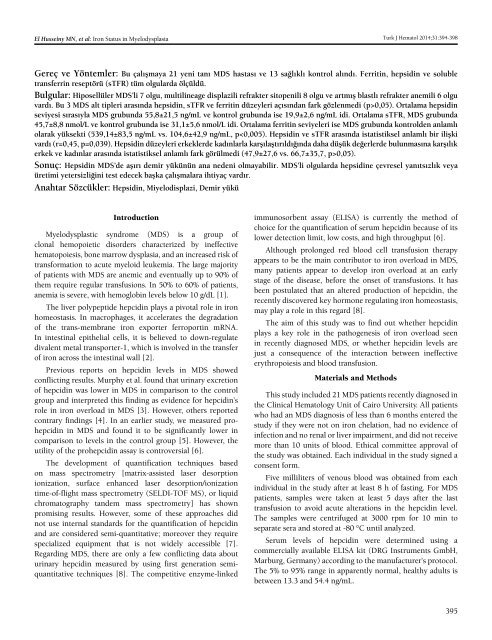Turkish Journal of Hematology Volume: 31 - Issue: 4
Create successful ePaper yourself
Turn your PDF publications into a flip-book with our unique Google optimized e-Paper software.
El Husseiny MN, et al: Iron Status in Myelodysplasia<br />
Turk J Hematol 2014;<strong>31</strong>:394-398<br />
Gereç ve Yöntemler: Bu çalışmaya 21 yeni tanı MDS hastası ve 13 sağlıklı kontrol alındı. Ferritin, hepsidin ve soluble<br />
transferrin reseptörü (sTFR) tüm olgularda ölçüldü.<br />
Bulgular: Hiposellüler MDS’li 7 olgu, multilineage displazili refrakter sitopenili 8 olgu ve artmış blastlı refrakter anemili 6 olgu<br />
vardı. Bu 3 MDS alt tipleri arasında hepsidin, sTFR ve ferritin düzeyleri açısından fark gözlenmedi (p>0,05). Ortalama hepsidin<br />
seviyesi sırasıyla MDS grubunda 55,8±21,5 ng/mL ve kontrol grubunda ise 19,9±2,6 ng/mL idi. Ortalama sTFR, MDS grubunda<br />
45,7±8,8 nmol/L ve kontrol grubunda ise <strong>31</strong>,1±5,6 nmol/L idi. Ortalama ferritin seviyeleri ise MDS grubunda kontrolden anlamlı<br />
olarak yüksekti (539,14±83,5 ng/mL vs. 104,6±42,9 ng/mL, p0,05).<br />
Sonuç: Hepsidin MDS’de aşırı demir yükünün ana nedeni olmayabilir. MDS’li olgularda hepsidine çevresel yanıtsızlık veya<br />
üretimi yetersizliğini test edecek başka çalışmalara ihtiyaç vardır.<br />
Anahtar Sözcükler: Hepsidin, Miyelodisplazi, Demir yükü<br />
Introduction<br />
Myelodysplastic syndrome (MDS) is a group <strong>of</strong><br />
clonal hemopoietic disorders characterized by ineffective<br />
hematopoiesis, bone marrow dysplasia, and an increased risk <strong>of</strong><br />
transformation to acute myeloid leukemia. The large majority<br />
<strong>of</strong> patients with MDS are anemic and eventually up to 90% <strong>of</strong><br />
them require regular transfusions. In 50% to 60% <strong>of</strong> patients,<br />
anemia is severe, with hemoglobin levels below 10 g/dL [1].<br />
The liver polypeptide hepcidin plays a pivotal role in iron<br />
homeostasis. In macrophages, it accelerates the degradation<br />
<strong>of</strong> the trans-membrane iron exporter ferroportin mRNA.<br />
In intestinal epithelial cells, it is believed to down-regulate<br />
divalent metal transporter-1, which is involved in the transfer<br />
<strong>of</strong> iron across the intestinal wall [2].<br />
Previous reports on hepcidin levels in MDS showed<br />
conflicting results. Murphy et al. found that urinary excretion<br />
<strong>of</strong> hepcidin was lower in MDS in comparison to the control<br />
group and interpreted this finding as evidence for hepcidin’s<br />
role in iron overload in MDS [3]. However, others reported<br />
contrary findings [4]. In an earlier study, we measured prohepcidin<br />
in MDS and found it to be significantly lower in<br />
comparison to levels in the control group [5]. However, the<br />
utility <strong>of</strong> the prohepcidin assay is controversial [6].<br />
The development <strong>of</strong> quantification techniques based<br />
on mass spectrometry [matrix-assisted laser desorption<br />
ionization, surface enhanced laser desorption/ionization<br />
time-<strong>of</strong>-flight mass spectrometry (SELDI-TOF MS), or liquid<br />
chromatography tandem mass spectrometry] has shown<br />
promising results. However, some <strong>of</strong> these approaches did<br />
not use internal standards for the quantification <strong>of</strong> hepcidin<br />
and are considered semi-quantitative; moreover they require<br />
specialized equipment that is not widely accessible [7].<br />
Regarding MDS, there are only a few conflicting data about<br />
urinary hepcidin measured by using first generation semiquantitative<br />
techniques [8]. The competitive enzyme-linked<br />
immunosorbent assay (ELISA) is currently the method <strong>of</strong><br />
choice for the quantification <strong>of</strong> serum hepcidin because <strong>of</strong> its<br />
lower detection limit, low costs, and high throughput [6].<br />
Although prolonged red blood cell transfusion therapy<br />
appears to be the main contributor to iron overload in MDS,<br />
many patients appear to develop iron overload at an early<br />
stage <strong>of</strong> the disease, before the onset <strong>of</strong> transfusions. It has<br />
been postulated that an altered production <strong>of</strong> hepcidin, the<br />
recently discovered key hormone regulating iron homeostasis,<br />
may play a role in this regard [8].<br />
The aim <strong>of</strong> this study was to find out whether hepcidin<br />
plays a key role in the pathogenesis <strong>of</strong> iron overload seen<br />
in recently diagnosed MDS, or whether hepcidin levels are<br />
just a consequence <strong>of</strong> the interaction between ineffective<br />
erythropoiesis and blood transfusion.<br />
Materials and Methods<br />
This study included 21 MDS patients recently diagnosed in<br />
the Clinical <strong>Hematology</strong> Unit <strong>of</strong> Cairo University. All patients<br />
who had an MDS diagnosis <strong>of</strong> less than 6 months entered the<br />
study if they were not on iron chelation, had no evidence <strong>of</strong><br />
infection and no renal or liver impairment, and did not receive<br />
more than 10 units <strong>of</strong> blood. Ethical committee approval <strong>of</strong><br />
the study was obtained. Each individual in the study signed a<br />
consent form.<br />
Five milliliters <strong>of</strong> venous blood was obtained from each<br />
individual in the study after at least 8 h <strong>of</strong> fasting. For MDS<br />
patients, samples were taken at least 5 days after the last<br />
transfusion to avoid acute alterations in the hepcidin level.<br />
The samples were centrifuged at 3000 rpm for 10 min to<br />
separate sera and stored at -80 °C until analyzed.<br />
Serum levels <strong>of</strong> hepcidin were determined using a<br />
commercially available ELISA kit (DRG Instruments GmbH,<br />
Marburg, Germany) according to the manufacturer’s protocol.<br />
The 5% to 95% range in apparently normal, healthy adults is<br />
between 13.3 and 54.4 ng/mL.<br />
395

















